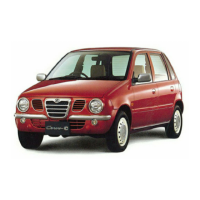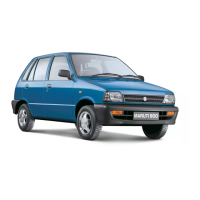Do you have a question about the MARUTI SUZUKI Zen and is the answer not in the manual?
Explains the meaning of WARNING, CAUTION, and NOTE signal words used in the manual.
Specifies the applicable vehicle model for this supplement.
Lists related service and wiring diagram manuals.
Provides guidance on navigating and utilizing the service manual effectively.
Outlines essential safety precautions for servicing the vehicle.
Details safety measures specific to working with the catalytic converter.
Lists important precautions for safely servicing electrical circuits.
Describes general methods for checking open and short circuits using tools.
Explains common causes and troubleshooting for intermittent electrical connections.
Advises on proper installation of mobile communication devices to protect the vehicle's electronics.
Information on identifying vehicle, engine, and transmission numbers.
Illustrates safe and correct points for lifting the vehicle using hoists or jacks.
Provides a glossary of abbreviations used throughout the manual.
Details metric fasteners, strength identification, and standard tightening torques.
Outlines recommended maintenance services and intervals up to 80,000 km.
Details specific maintenance procedures for engine components.
Instructions on replacing the camshaft timing belt, including cautions.
Procedure for inspecting and adjusting valve lash, with specifications.
Steps for changing engine oil and filter, including oil viscosity recommendations.
Procedure for changing engine coolant, including warnings and cautions.
Guidelines for inspecting the exhaust system for damage, leaks, and proper mounting.
Covers spark plug replacement and distributor cap/rotor inspection.
Details air cleaner filter inspection/replacement and fuel lines inspection.
Procedure for replacing the fuel filter, with safety warnings.
How to inspect the fuel tank for damage, leaks, and corrosion.
Inspection of the fuel filler cap and gasket for damage or deterioration.
Covers PCV valve inspection and EVAP system check.
Procedures for inspecting brake discs, pads, drums, shoes, hoses, and pipes.
Steps for changing brake fluid, including cautions on fluid type.
Inspection of parking brake lever and cable for wear and operation.
Inspection of clutch pedal free travel.
Inspection of tires for wear/damage and wheel discs for dents/cracks.
Instructions on rotating tires to equalize wear.
Procedures for inspecting front and rear wheel bearings.
Inspection of drive shaft boots for leaks, detachment, or tears.
Inspection of front struts, rear shock absorbers, and suspension arms for damage.
Inspection of steering wheel play, linkage, gear case, and alignment.
Steps for checking and changing manual transmission oil level and oil.
Procedure for checking the automatic transmission fluid level.
Inspection of doors, engine hood latches, hinges, and locks for proper function.
Covers checks for seats, seat belts, battery electrolyte, accelerator pedal, and engine start.
Checking the exhaust system for leaks, cracks, and loose supports.
Checks for proper clutch release, engagement, and overall condition.
Checks for smooth shifting and proper indicator function for transmission selection.
Checks for proper pedal travel, braking performance, noise, and drag.
Checks for steering wheel stability, pull, and abnormal feeling.
Checks engine response, noise, and vibration for any abnormalities.
Checks for abnormal noise or vibration in these systems.
Verifies accurate operation of speedometer, odometer, fuel, and temperature gauges.
Ensures all exterior and interior lights operate correctly.
Checks defroster outlet operation with heater/AC.
Lists recommended fluids and lubricants for various vehicle systems.
Overview of the air conditioning system and refrigerant types used.
Diagram and explanation of how refrigerant circulates through the AC system.
Identifies and locates key components of the air conditioning system.
General diagnosis table for common AC system issues and possible causes.
Troubleshooting guide for noises originating from the AC compressor.
Troubleshooting guide for noises related to the magnetic clutch.
Troubleshooting guide for noises emanating from AC system tubing.
Troubleshooting guide for vibrations or noises from the condenser.
Troubleshooting guide for noises originating from the crankshaft pulley.
Troubleshooting guide for noises from the tension pulley.
Troubleshooting guide for whistling sounds from the evaporator.
Troubleshooting guide for chirping or droning noises from the blower motor.
Procedure for quickly checking the refrigerant charge level using the sight glass.
Steps to diagnose AC performance issues under specific operating conditions.
Electrical schematic illustrating the AC system's wiring connections.
Procedures for checking the ECM and its associated circuits using voltage measurements.
Table listing normal voltage values at ECM terminals under various conditions.
Steps for checking and adjusting the AC compressor drive belt tension.
Safety warnings and procedures for handling refrigerant.
Step-by-step process for charging the AC system with refrigerant.
Procedure for evacuating the AC system using a vacuum pump and manifold gauge set.
Method for charging the AC system with refrigerant, including cautions.
Steps for safely removing the manifold gauge set after charging.
Methods for testing the AC system for refrigerant leaks.
Guidelines for proper installation and connection of AC system hoses and pipes.
Safety precautions and handling procedures for CFC-12 refrigerant.
Procedure for recovering refrigerant using specialized equipment.
Inspection, removal, and installation procedures for the AC condenser.
How to check the continuity of the condenser cooling fan motor.
Inspection, removal, and installation procedures for the receiver/dryer.
Removal, disassembly, and inspection procedures for the evaporator unit.
Inspection, removal, and installation procedures for the expansion valve.
Checks resistance of the evaporator thermistor at different temperatures.
Inspection, removal, and installation procedures for refrigerant lines.
Inspection and testing of the dual pressure switch for continuity and operation.
Removal, inspection, and installation of the AC switch.
How to inspect AC condenser fan motor relay and AC compressor relay.
Removal and installation procedures for the AC compressor assembly.
Inspection, removal, and assembly procedures for the magnet clutch.
Steps for assembling the magnet clutch, including clearance adjustment.
Exploded view and part numbers for the compressor assembly.
Overview of the EPS system components and their functions.
Identifies the main parts of the EPS system.
Electrical schematic of the EPS system showing connections and terminals.
General information on diagnosing EPS system malfunctions.
Explanation of the EPS system's self-diagnosis capabilities and DTCs.
Important precautions to observe before and during EPS system diagnosis.
A step-by-step guide for diagnosing EPS system problems.
Sample questionnaire to gather information about EPS system problems.
How to check Diagnostic Trouble Codes (DTCs) using a voltmeter.
Steps to clear stored DTCs from the EPS control module memory.
Table listing DTCs, their corresponding voltmeter deflection patterns, and diagnostic items.
Troubleshooting steps for torque sensor main sensor circuit failure.
Troubleshooting steps for torque sensor main and sub sensor circuit failure.
Troubleshooting steps for torque sensor sub sensor circuit failure.
Troubleshooting steps for torque sensor 5V power supply circuit failure.
Troubleshooting steps for Vehicle Speed Sensor (VSS) circuit failures.
Troubleshooting steps for engine speed signal circuit failures.
Troubleshooting steps for motor circuit failures in the EPS system.
Troubleshooting steps for clutch circuit failures in the EPS system.
Troubleshooting steps for power supply circuit failures of the P/S control module.
Troubleshooting steps for failures within the P/S control module itself.
Procedures for inspecting the P/S control module circuits by measuring voltage.
Diagram showing terminal layouts for P/S control module connectors.
Troubleshooting steps for symptoms not covered by DTCs.
How to check and measure steering wheel play for looseness or rattle.
Procedure to measure steering force using a torque wrench.
General service procedures for steering column assembly and P/S control module.
Removal and installation of the steering column assembly.
Procedures for inspecting steering column and shaft for damage after an accident.
Removal and installation of the P/S control module.
Inspection of torque sensor voltage output based on steering wheel position.
Inspection of motor assembly resistance and continuity to body ground.
Procedures related to the steering wheel and column components.
Inspecting steering column assembly and lower shaft for damage after impact.
General information about the engine and its components.
Emphasizes the importance of cleanliness and proper handling of engine parts during service.
Overview of engine diagnosis, including on-board diagnostics and flow tables.
Explanation of the ECM's self-diagnosis function for engine malfunctions.
Important safety and procedural precautions for engine diagnosis.
A flowchart to guide the troubleshooting process for engine issues.
Guidance on gathering customer information about vehicle problems.
Basic engine checks and a table for diagnosing engine conditions.
Steps for troubleshooting issues based on indicated DTCs.
Guidance on diagnosing and resolving intermittent issues in engine systems.
Procedures for verifying that repairs have resolved the issue and confirming normal operation.
A table correlating engine conditions with possible causes and reference items.
Diagnosis and causes for engine detonation, characterized by knocking sounds.
Diagnosis of engine overheating causes, including thermostat, water pump, and coolant issues.
Diagnosis of causes for reduced fuel economy.
Diagnosis of causes for excessive engine oil consumption.
Diagnosis of causes for low engine oil pressure.
General notes on diagnosing engine noise, including proper adjustment and fuel use.
Diagnosis for excessive hydrocarbon and carbon monoxide emissions.
Diagnosis for excessive nitrogen oxides emissions.
Description of the engine's basic configuration, cooling, and SOHC valve mechanism.
Explanation of the engine lubrication system, oil pump, and oil flow paths.
Procedures for checks performed with the engine installed in the vehicle.
Steps for measuring cylinder compression pressure with specifications.
Procedure for checking engine vacuum using a vacuum gauge.
Steps for measuring engine oil pressure with a gauge.
Procedure for checking and adjusting valve lash, including specifications.
Removal, inspection, cleaning, and installation of the air cleaner filter.
Removal and installation procedures for the air cleaner assembly.
Removal and installation procedures for the air cleaner outlet hose.
Removal and installation procedures for the cylinder head cover, including gasket and O-ring.
Removal and installation procedures for throttle body and intake manifold.
Removal and installation procedures for the exhaust manifold, including gasket and sensor.
Detailed procedures for removal and installation of the timing belt and tensioner.
Critical warnings regarding camshaft and crankshaft rotation after timing belt removal.
Procedures for inspecting the timing belt for wear and the tensioner for smooth rotation.
Steps for installing the timing belt, tensioner, and related components.
Procedures for removal, disassembly, cleaning, and inspection of pistons and related parts.
Inspecting cylinder walls for wear, taper, and out-of-round conditions.
Inspecting pistons for faults, cracks, and measuring piston diameter.
How to measure piston-to-cylinder clearance and the required specifications.
Measuring clearance between piston rings and their grooves.
Inspecting piston pin, connecting rod small end bore, and piston bore for wear.
Measuring piston ring end gap and ensuring correct installation.
Checking big-end side clearance and connecting rod alignment (bow and twist).
Steps for installing pistons and connecting rods, including bearing cap tightening.
Removal, inspection, and installation of main bearings, crankshaft, and cylinder block.
Checking crankshaft runout, thrust play, and journal condition.
General information, inspection, and clearance measurement for main bearings.
How to select and install main bearings based on journal diameter and color coding.
Information on selecting and using 0.25 mm undersize bearings.
Inspecting the flywheel for damage, wear, and runout.
Checking and correcting gasketed surface flatness on the cylinder block.
Procedures for honing or reboring cylinders and selecting oversized pistons.
Steps for installing the crankshaft, bearing caps, and flywheel/drive plate.
General section for overhauling engine unit components.
Removal and installation procedures for engine mounting components.
Procedures for removing and installing the entire engine assembly.
Warning about using only unleaded fuel, especially with catalytic converters.
Overview of the fuel system components and their functions.
Lists main components of the fuel system and lines.
General precautions and procedures for servicing the fuel system.
Critical safety warnings for performing fuel system service.
Visual inspection of fuel lines for leaks, cracks, and damage.
Removal and installation procedures for fuel pipes, including clamp positioning.
Inspection of the fuel filler cap and gasket for damage.
Removal and installation procedures for the fuel filter.
Warning, removal, inspection, and installation procedures for the fuel tank.
Removal, inspection, and installation procedures for the fuel pump assembly.
Inspection, removal, and installation procedures for the fuel pressure regulator.
On-vehicle inspection, removal, and installation procedures for fuel injectors.
Overview of the engine and emission control system and its subsystems.
Description of air intake system parts like air cleaner, throttle body, and IAC valve.
Overview of fuel delivery system components: tank, pump, filter, regulator, injectors.
Explanation of the electronic control system, sensors, ECM, and controlled devices.
General information on diagnosing engine and emission control system malfunctions.
How the ECM/PCM performs self-diagnosis and operates the malfunction indicator lamp.
Important precautions for diagnosing system faults, including ECM/PCM handling.
Procedures for checking the MIL operation when the ignition is ON or engine is running.
How to check DTCs using a SUZUKI scan tool or by flashing patterns.
Procedures for erasing DTCs from the ECM (PCM) memory.
Table listing DTCs, MIL flashing patterns, diagnostic items, and diagnosis.
Troubleshooting steps when the Malfunction Indicator Lamp does not light at ignition ON.
Troubleshooting steps when the Malfunction Indicator Lamp flashes at ignition ON.
Troubleshooting steps when the MIL does not flash or remains on.
Checking ECM power and ground circuits, starting with main relay and fuse checks.
Continues checking ECM power and ground circuits, including main relay and circuit checks.
Troubleshooting for Manifold Absolute Pressure (MAP) sensor circuit issues (voltage low/high/problem).
Troubleshooting for Throttle Position (TP) sensor circuit issues (voltage high/low).
Troubleshooting for Oxygen (O2) sensor circuit issues (signal voltage not changing).
Troubleshooting for Camshaft Position (CMP) sensor circuit (signal not inputted).
Troubleshooting for Vehicle Speed Sensor (VSS) circuit failure in manual transmission vehicles.
Troubleshooting for Vehicle Speed Sensor (VSS) circuit failure in automatic transmission vehicles.
Troubleshooting for Intake Air Temperature (IAT) sensor circuit issues (voltage high/low).
Troubleshooting for Engine Coolant Temperature (ECT) sensor circuit issues (voltage high/low).
Procedures to confirm DTCs after repairs, including driving test conditions.
Steps to check the fuel pump operation and its circuit for faults.
Procedures for checking fuel injector operation sound and resistance.
Steps for checking fuel pressure using a gauge, including initial pressure readings.
Continues fuel pressure checks, including leakage and regulator function.
Procedures for checking engine idle speed and IAC duty using a scan tool or duty meter.
Checking the EVAP canister purge system, vacuum passages, and hoses.
Inspection of the EVAP canister purge valve resistance and operation.
Inspection of the EVAP canister by checking vacuum passages.
Inspection of the tank pressure control valve for proper air flow.
Inspection of PCV valve and hoses for obstructions or leaks.
Inspection of PCV hoses for connection, leakage, clog, and deterioration.
Checking PCV valve for vacuum and rattle sound.
Lists special tools required for engine and emission control system service.
Torque specifications for various fasteners in the engine and emission control system.
Overview of the ignition system components and their functions.
Identifies the main parts of the ignition system.
Electrical schematic of the ignition system's wiring.
General troubleshooting guide for ignition system problems.
A flowchart for diagnosing ignition system issues based on symptoms.
Procedures for performing service on the ignition system with the engine installed.
Steps to test for spark at the spark plugs, with safety warnings.
Removal, inspection, and installation of high-tension cords.
Removal, inspection, and installation of spark plugs, including specifications.
Removal, installation, and inspection of the noise suppressor.
Inspection and replacement procedures for the igniter.
How to measure primary and secondary coil resistances.
Inspection of distributor cap, rotor, and signal rotor air gap.
Procedures for checking and adjusting ignition timing using a timing light or scan tool.
Overview of the cranking circuit components and their electrical connections.
Explanation of the electrical circuit for engine cranking.
How the starting motor circuit engages the engine flywheel and initiates cranking.
Exploded view and identification of starting motor components.
Troubleshooting guide for symptoms related to starting system problems.
Detailed procedures for dismounting, disassembly, and reassembly of the starting motor.
Steps for disassembling the starting motor, including removing housing and brushes.
Steps for reassembling the starting motor, including installing brushes and magnetic switch.
Inspection procedures for the plunger, magnetic switch, pull-in coil, and brush holder.
Measuring brush length and replacing brushes if worn.
Checking brush springs and holder for rust, breakage, or insulation issues.
Ground test and open circuit test for the armature's commutator and segments.
Checking the yoke's field coil for continuity.
Inspecting the pinion for wear and checking clutch lock-up and rotation.
Procedures for pull-in test, hold-in test, and no-load performance test.
How to test the pinion engagement mechanism of the starting motor.
How to test if the pinion remains engaged after initial engagement.
Checking if the pinion returns inward correctly after disengaging.
Testing motor operation and current draw without load.
Technical specifications for the starting motor's performance and output.
Lists required service materials like grease for starting motor components.
Lists special tools required for starting motor service.
Overview of the charging system components: battery, generator, and regulator.
General description of battery functions, types, carrier, and electrolyte freezing/sulfation.
Precautions for battery handling, storage, charging, and terminal cleaning.
Description of generator features, internal components, and connections.
Troubleshooting guide for issues with the charge indicator lamp.
Causes and checks for an undercharged battery condition, including wiring and connections.
Troubleshooting steps when charging system voltage is higher than standard.
Troubleshooting steps when charging system voltage is lower than standard.
Procedure to check charging system current and voltage under load.
Diagnosis of overcharged battery conditions and checks for generator field windings.
Technical specifications for the vehicle's battery.
Technical specifications for the generator's rated voltage, output, speed, and polarity.
Detailed procedures for disassembling and assembling the generator.
Steps for disassembling the generator, including removing housing, brushes, and stator.
Inspection procedures for the rotor, stator, slip rings, and brushes.
Measuring brush length and replacing worn brushes.
Checking the positive and negative rectifier for continuity.
Checking drive end and end housing bearings for roughness or wear.
Procedures for unsoldering, replacing, and soldering new generator brushes.
Steps for assembling the generator, including installing rotor, stator, and covers.
Belt tension inspection, removal, and installation procedures.
Warning about using only unleaded fuel, especially with catalytic converters.
Overview of the exhaust system components and the function of the three-way catalytic converter.
Procedures for checking rubber mountings, connections, and for exhaust fumes.
Service procedures for the exhaust manifold and exhaust pipe.
Checking the exhaust manifold gasket and seal for deterioration.
Replacement procedure for the exhaust pipe, including torque specifications and leakage check.
Information on the terminal arrangement of the combination meter couplers.
Service procedures for headlights and the ECT sensor.
Removal and installation procedures for the round type headlight assembly.
Inspecting the ECT sensor resistance at different temperatures.
Inspection of the power window main switch for continuity.
Inspection of the main power window switch terminals and continuity.
Inspection of the power window sub switch terminals for continuity.
Explains the meaning of WARNING, CAUTION, and NOTE signal words used in the manual.
Specifies the applicable vehicle model for this supplement.
Lists related service and wiring diagram manuals.
Provides guidance on navigating and utilizing the service manual effectively.
Outlines essential safety precautions for servicing the vehicle.
Details safety measures specific to working with the catalytic converter.
Lists important precautions for safely servicing electrical circuits.
Describes general methods for checking open and short circuits using tools.
Explains common causes and troubleshooting for intermittent electrical connections.
Advises on proper installation of mobile communication devices to protect the vehicle's electronics.
Information on identifying vehicle, engine, and transmission numbers.
Illustrates safe and correct points for lifting the vehicle using hoists or jacks.
Provides a glossary of abbreviations used throughout the manual.
Details metric fasteners, strength identification, and standard tightening torques.
Outlines recommended maintenance services and intervals up to 80,000 km.
Details specific maintenance procedures for engine components.
Instructions on replacing the camshaft timing belt, including cautions.
Procedure for inspecting and adjusting valve lash, with specifications.
Steps for changing engine oil and filter, including oil viscosity recommendations.
Procedure for changing engine coolant, including warnings and cautions.
Guidelines for inspecting the exhaust system for damage, leaks, and proper mounting.
Covers spark plug replacement and distributor cap/rotor inspection.
Details air cleaner filter inspection/replacement and fuel lines inspection.
Procedure for replacing the fuel filter, with safety warnings.
How to inspect the fuel tank for damage, leaks, and corrosion.
Inspection of the fuel filler cap and gasket for damage or deterioration.
Covers PCV valve inspection and EVAP system check.
Procedures for inspecting brake discs, pads, drums, shoes, hoses, and pipes.
Steps for changing brake fluid, including cautions on fluid type.
Inspection of parking brake lever and cable for wear and operation.
Inspection of clutch pedal free travel.
Inspection of tires for wear/damage and wheel discs for dents/cracks.
Instructions on rotating tires to equalize wear.
Procedures for inspecting front and rear wheel bearings.
Inspection of drive shaft boots for leaks, detachment, or tears.
Inspection of front struts, rear shock absorbers, and suspension arms for damage.
Inspection of steering wheel play, linkage, gear case, and alignment.
Steps for checking and changing manual transmission oil level and oil.
Procedure for checking the automatic transmission fluid level.
Inspection of doors, engine hood latches, hinges, and locks for proper function.
Covers checks for seats, seat belts, battery electrolyte, accelerator pedal, and engine start.
Checking the exhaust system for leaks, cracks, and loose supports.
Checks for proper clutch release, engagement, and overall condition.
Checks for smooth shifting and proper indicator function for transmission selection.
Checks for proper pedal travel, braking performance, noise, and drag.
Checks for steering wheel stability, pull, and abnormal feeling.
Checks engine response, noise, and vibration for any abnormalities.
Checks for abnormal noise or vibration in these systems.
Verifies accurate operation of speedometer, odometer, fuel, and temperature gauges.
Ensures all exterior and interior lights operate correctly.
Checks defroster outlet operation with heater/AC.
Lists recommended fluids and lubricants for various vehicle systems.
Overview of the air conditioning system and refrigerant types used.
Diagram and explanation of how refrigerant circulates through the AC system.
Identifies and locates key components of the air conditioning system.
General diagnosis table for common AC system issues and possible causes.
Troubleshooting guide for noises originating from the AC compressor.
Troubleshooting guide for noises related to the magnetic clutch.
Troubleshooting guide for noises emanating from AC system tubing.
Troubleshooting guide for vibrations or noises from the condenser.
Troubleshooting guide for noises originating from the crankshaft pulley.
Troubleshooting guide for noises from the tension pulley.
Troubleshooting guide for whistling sounds from the evaporator.
Troubleshooting guide for chirping or droning noises from the blower motor.
Procedure for quickly checking the refrigerant charge level using the sight glass.
Steps to diagnose AC performance issues under specific operating conditions.
Electrical schematic illustrating the AC system's wiring connections.
Procedures for checking the ECM and its associated circuits using voltage measurements.
Table listing normal voltage values at ECM terminals under various conditions.
Steps for checking and adjusting the AC compressor drive belt tension.
Safety warnings and procedures for handling refrigerant.
Step-by-step process for charging the AC system with refrigerant.
Procedure for evacuating the AC system using a vacuum pump and manifold gauge set.
Method for charging the AC system with refrigerant, including cautions.
Steps for safely removing the manifold gauge set after charging.
Methods for testing the AC system for refrigerant leaks.
Guidelines for proper installation and connection of AC system hoses and pipes.
Safety precautions and handling procedures for CFC-12 refrigerant.
Procedure for recovering refrigerant using specialized equipment.
Inspection, removal, and installation procedures for the AC condenser.
How to check the continuity of the condenser cooling fan motor.
Inspection, removal, and installation procedures for the receiver/dryer.
Removal, disassembly, and inspection procedures for the evaporator unit.
Inspection, removal, and installation procedures for the expansion valve.
Checks resistance of the evaporator thermistor at different temperatures.
Inspection, removal, and installation procedures for refrigerant lines.
Inspection and testing of the dual pressure switch for continuity and operation.
Removal, inspection, and installation of the AC switch.
How to inspect AC condenser fan motor relay and AC compressor relay.
Removal and installation procedures for the AC compressor assembly.
Inspection, removal, and assembly procedures for the magnet clutch.
Steps for assembling the magnet clutch, including clearance adjustment.
Exploded view and part numbers for the compressor assembly.
Overview of the EPS system components and their functions.
Identifies the main parts of the EPS system.
Electrical schematic of the EPS system showing connections and terminals.
General information on diagnosing EPS system malfunctions.
Explanation of the EPS system's self-diagnosis capabilities and DTCs.
Important precautions to observe before and during EPS system diagnosis.
A step-by-step guide for diagnosing EPS system problems.
Sample questionnaire to gather information about EPS system problems.
How to check Diagnostic Trouble Codes (DTCs) using a voltmeter.
Steps to clear stored DTCs from the EPS control module memory.
Table listing DTCs, their corresponding voltmeter deflection patterns, and diagnostic items.
Troubleshooting steps for torque sensor main sensor circuit failure.
Troubleshooting steps for torque sensor main and sub sensor circuit failure.
Troubleshooting steps for torque sensor sub sensor circuit failure.
Troubleshooting steps for torque sensor 5V power supply circuit failure.
Troubleshooting steps for Vehicle Speed Sensor (VSS) circuit failures.
Troubleshooting steps for engine speed signal circuit failures.
Troubleshooting steps for motor circuit failures in the EPS system.
Troubleshooting steps for clutch circuit failures in the EPS system.
Troubleshooting steps for power supply circuit failures of the P/S control module.
Troubleshooting steps for failures within the P/S control module itself.
Procedures for inspecting the P/S control module circuits by measuring voltage.
Diagram showing terminal layouts for P/S control module connectors.
Troubleshooting steps for symptoms not covered by DTCs.
How to check and measure steering wheel play for looseness or rattle.
Procedure to measure steering force using a torque wrench.
General service procedures for steering column assembly and P/S control module.
Removal and installation of the steering column assembly.
Procedures for inspecting steering column and shaft for damage after an accident.
Removal and installation of the P/S control module.
Inspection of torque sensor voltage output based on steering wheel position.
Inspection of motor assembly resistance and continuity to body ground.
Procedures related to the steering wheel and column components.
Inspecting steering column assembly and lower shaft for damage after impact.
General information about the engine and its components.
Emphasizes the importance of cleanliness and proper handling of engine parts during service.
Overview of engine diagnosis, including on-board diagnostics and flow tables.
Explanation of the ECM's self-diagnosis function for engine malfunctions.
Important safety and procedural precautions for engine diagnosis.
A flowchart to guide the troubleshooting process for engine issues.
Guidance on gathering customer information about vehicle problems.
Basic engine checks and a table for diagnosing engine conditions.
Steps for troubleshooting issues based on indicated DTCs.
Guidance on diagnosing and resolving intermittent issues in engine systems.
Procedures for verifying that repairs have resolved the issue and confirming normal operation.
A table correlating engine conditions with possible causes and reference items.
Diagnosis and causes for engine detonation, characterized by knocking sounds.
Diagnosis of engine overheating causes, including thermostat, water pump, and coolant issues.
Diagnosis of causes for reduced fuel economy.
Diagnosis of causes for excessive engine oil consumption.
Diagnosis of causes for low engine oil pressure.
General notes on diagnosing engine noise, including proper adjustment and fuel use.
Diagnosis for excessive hydrocarbon and carbon monoxide emissions.
Diagnosis for excessive nitrogen oxides emissions.
Description of the engine's basic configuration, cooling, and SOHC valve mechanism.
Explanation of the engine lubrication system, oil pump, and oil flow paths.
Procedures for checks performed with the engine installed in the vehicle.
Steps for measuring cylinder compression pressure with specifications.
Procedure for checking engine vacuum using a vacuum gauge.
Steps for measuring engine oil pressure with a gauge.
Procedure for checking and adjusting valve lash, including specifications.
Removal, inspection, cleaning, and installation of the air cleaner filter.
Removal and installation procedures for the air cleaner assembly.
Removal and installation procedures for the air cleaner outlet hose.
Removal and installation procedures for the cylinder head cover, including gasket and O-ring.
Removal and installation procedures for throttle body and intake manifold.
Removal and installation procedures for the exhaust manifold, including gasket and sensor.
Detailed procedures for removal and installation of the timing belt and tensioner.
Critical warnings regarding camshaft and crankshaft rotation after timing belt removal.
Procedures for inspecting the timing belt for wear and the tensioner for smooth rotation.
Steps for installing the timing belt, tensioner, and related components.
Procedures for removal, disassembly, cleaning, and inspection of pistons and related parts.
Inspecting cylinder walls for wear, taper, and out-of-round conditions.
Inspecting pistons for faults, cracks, and measuring piston diameter.
How to measure piston-to-cylinder clearance and the required specifications.
Measuring clearance between piston rings and their grooves.
Inspecting piston pin, connecting rod small end bore, and piston bore for wear.
Measuring piston ring end gap and ensuring correct installation.
Checking big-end side clearance and connecting rod alignment (bow and twist).
Steps for installing pistons and connecting rods, including bearing cap tightening.
Removal, inspection, and installation of main bearings, crankshaft, and cylinder block.
Checking crankshaft runout, thrust play, and journal condition.
General information, inspection, and clearance measurement for main bearings.
How to select and install main bearings based on journal diameter and color coding.
Information on selecting and using 0.25 mm undersize bearings.
Inspecting the flywheel for damage, wear, and runout.
Checking and correcting gasketed surface flatness on the cylinder block.
Procedures for honing or reboring cylinders and selecting oversized pistons.
Steps for installing the crankshaft, bearing caps, and flywheel/drive plate.
General section for overhauling engine unit components.
Removal and installation procedures for engine mounting components.
Procedures for removing and installing the entire engine assembly.
Warning about using only unleaded fuel, especially with catalytic converters.
Overview of the fuel system components and their functions.
Lists main components of the fuel system and lines.
General precautions and procedures for servicing the fuel system.
Critical safety warnings for performing fuel system service.
Visual inspection of fuel lines for leaks, cracks, and damage.
Removal and installation procedures for fuel pipes, including clamp positioning.
Inspection of the fuel filler cap and gasket for damage.
Removal and installation procedures for the fuel filter.
Warning, removal, inspection, and installation procedures for the fuel tank.
Removal, inspection, and installation procedures for the fuel pump assembly.
Inspection, removal, and installation procedures for the fuel pressure regulator.
On-vehicle inspection, removal, and installation procedures for fuel injectors.
Overview of the engine and emission control system and its subsystems.
Description of air intake system parts like air cleaner, throttle body, and IAC valve.
Overview of fuel delivery system components: tank, pump, filter, regulator, injectors.
Explanation of the electronic control system, sensors, ECM, and controlled devices.
General information on diagnosing engine and emission control system malfunctions.
How the ECM/PCM performs self-diagnosis and operates the malfunction indicator lamp.
Important precautions for diagnosing system faults, including ECM/PCM handling.
Procedures for checking the MIL operation when the ignition is ON or engine is running.
How to check DTCs using a SUZUKI scan tool or by flashing patterns.
Procedures for erasing DTCs from the ECM (PCM) memory.
Table listing DTCs, MIL flashing patterns, diagnostic items, and diagnosis.
Troubleshooting steps when the Malfunction Indicator Lamp does not light at ignition ON.
Troubleshooting steps when the Malfunction Indicator Lamp flashes at ignition ON.
Troubleshooting steps when the MIL does not flash or remains on.
Checking ECM power and ground circuits, starting with main relay and fuse checks.
Continues checking ECM power and ground circuits, including main relay and circuit checks.
Troubleshooting for Manifold Absolute Pressure (MAP) sensor circuit issues (voltage low/high/problem).
Troubleshooting for Throttle Position (TP) sensor circuit issues (voltage high/low).
Troubleshooting for Oxygen (O2) sensor circuit issues (signal voltage not changing).
Troubleshooting for Camshaft Position (CMP) sensor circuit (signal not inputted).
Troubleshooting for Vehicle Speed Sensor (VSS) circuit failure in manual transmission vehicles.
Troubleshooting for Vehicle Speed Sensor (VSS) circuit failure in automatic transmission vehicles.
Troubleshooting for Intake Air Temperature (IAT) sensor circuit issues (voltage high/low).
Troubleshooting for Engine Coolant Temperature (ECT) sensor circuit issues (voltage high/low).
Procedures to confirm DTCs after repairs, including driving test conditions.
Steps to check the fuel pump operation and its circuit for faults.
Procedures for checking fuel injector operation sound and resistance.
Steps for checking fuel pressure using a gauge, including initial pressure readings.
Continues fuel pressure checks, including leakage and regulator function.
Procedures for checking engine idle speed and IAC duty using a scan tool or duty meter.
Checking the EVAP canister purge system, vacuum passages, and hoses.
Inspection of the EVAP canister purge valve resistance and operation.
Inspection of the EVAP canister by checking vacuum passages.
Inspection of the tank pressure control valve for proper air flow.
Inspection of PCV valve and hoses for obstructions or leaks.
Inspection of PCV hoses for connection, leakage, clog, and deterioration.
Checking PCV valve for vacuum and rattle sound.
Lists special tools required for engine and emission control system service.
Torque specifications for various fasteners in the engine and emission control system.
Overview of the ignition system components and their functions.
Identifies the main parts of the ignition system.
Electrical schematic of the ignition system's wiring.
General troubleshooting guide for ignition system problems.
A flowchart for diagnosing ignition system issues based on symptoms.
Procedures for performing service on the ignition system with the engine installed.
Steps to test for spark at the spark plugs, with safety warnings.
Removal, inspection, and installation of high-tension cords.
Removal, inspection, and installation of spark plugs, including specifications.
Removal, installation, and inspection of the noise suppressor.
Inspection and replacement procedures for the igniter.
How to measure primary and secondary coil resistances.
Inspection of distributor cap, rotor, and signal rotor air gap.
Procedures for checking and adjusting ignition timing using a timing light or scan tool.
Overview of the cranking circuit components and their electrical connections.
Explanation of the electrical circuit for engine cranking.
How the starting motor circuit engages the engine flywheel and initiates cranking.
Exploded view and identification of starting motor components.
Troubleshooting guide for symptoms related to starting system problems.
Detailed procedures for dismounting, disassembly, and reassembly of the starting motor.
Steps for disassembling the starting motor, including removing housing and brushes.
Steps for reassembling the starting motor, including installing brushes and magnetic switch.
Inspection procedures for the plunger, magnetic switch, pull-in coil, and brush holder.
Measuring brush length and replacing brushes if worn.
Checking brush springs and holder for rust, breakage, or insulation issues.
Ground test and open circuit test for the armature's commutator and segments.
Checking the yoke's field coil for continuity.
Inspecting the pinion for wear and checking clutch lock-up and rotation.
Procedures for pull-in test, hold-in test, and no-load performance test.
How to test the pinion engagement mechanism of the starting motor.
How to test if the pinion remains engaged after initial engagement.
Checking if the pinion returns inward correctly after disengaging.
Testing motor operation and current draw without load.
Technical specifications for the starting motor's performance and output.
Lists required service materials like grease for starting motor components.
Lists special tools required for starting motor service.
Overview of the charging system components: battery, generator, and regulator.
General description of battery functions, types, carrier, and electrolyte freezing/sulfation.
Precautions for battery handling, storage, charging, and terminal cleaning.
Description of generator features, internal components, and connections.
Troubleshooting guide for issues with the charge indicator lamp.
Causes and checks for an undercharged battery condition, including wiring and connections.
Troubleshooting steps when charging system voltage is higher than standard.
Troubleshooting steps when charging system voltage is lower than standard.
Procedure to check charging system current and voltage under load.
Diagnosis of overcharged battery conditions and checks for generator field windings.
Technical specifications for the vehicle's battery.
Technical specifications for the generator's rated voltage, output, speed, and polarity.
Detailed procedures for disassembling and assembling the generator.
Steps for disassembling the generator, including removing housing, brushes, and stator.
Inspection procedures for the rotor, stator, slip rings, and brushes.
Measuring brush length and replacing worn brushes.
Checking the positive and negative rectifier for continuity.
Checking drive end and end housing bearings for roughness or wear.
Procedures for unsoldering, replacing, and soldering new generator brushes.
Steps for assembling the generator, including installing rotor, stator, and covers.
Belt tension inspection, removal, and installation procedures.
Warning about using only unleaded fuel, especially with catalytic converters.
Overview of the exhaust system components and the function of the three-way catalytic converter.
Procedures for checking rubber mountings, connections, and for exhaust fumes.
Service procedures for the exhaust manifold and exhaust pipe.
Checking the exhaust manifold gasket and seal for deterioration.
Replacement procedure for the exhaust pipe, including torque specifications and leakage check.
Information on the terminal arrangement of the combination meter couplers.
Service procedures for headlights and the ECT sensor.
Removal and installation procedures for the round type headlight assembly.
Inspecting the ECT sensor resistance at different temperatures.
Inspection of the power window main switch for continuity.
Inspection of the main power window switch terminals and continuity.
Inspection of the power window sub switch terminals for continuity.
| Brand | MARUTI SUZUKI |
|---|---|
| Model | Zen |
| Category | Automobile |
| Language | English |












